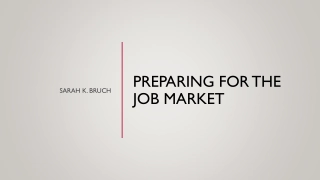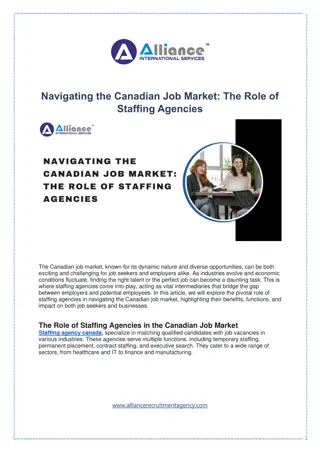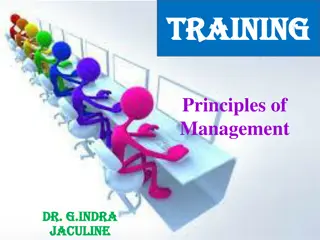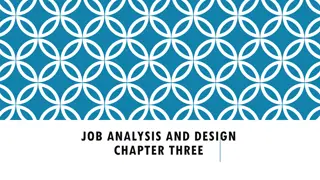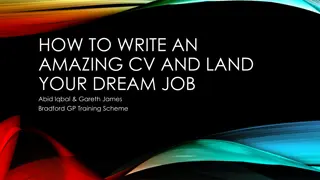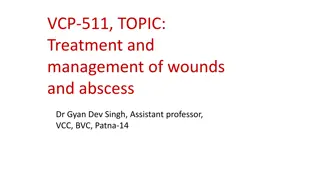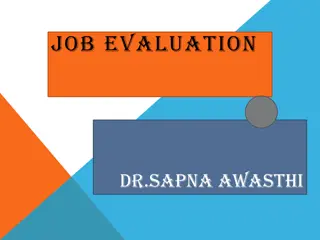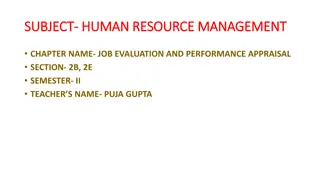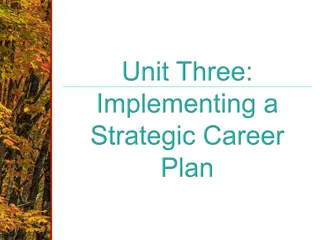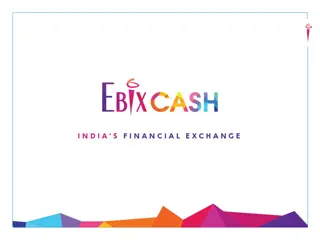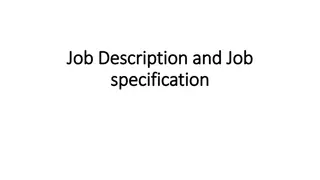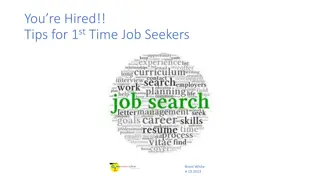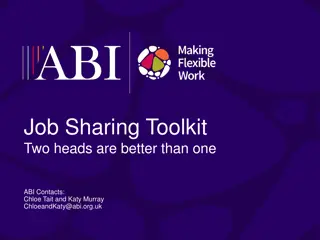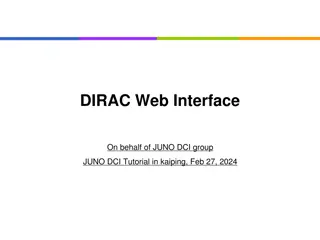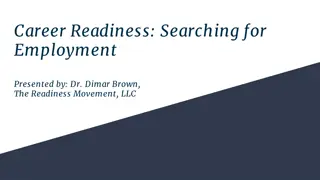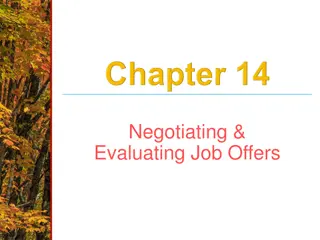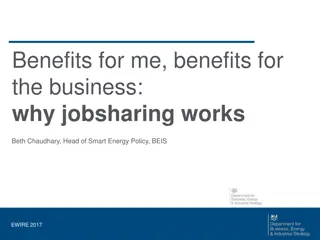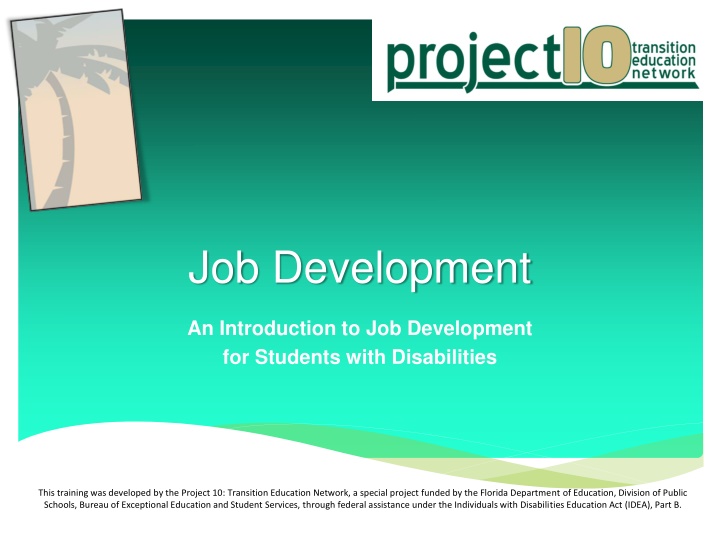
Strategies for Job Development for Students with Disabilities
Learn about state and federal initiatives supporting students with disabilities, key terms, effective job development steps, and additional resources. Explore recommendations from Governor's Commission on Jobs for Floridians with Disabilities and Executive Order 13-284 promoting integrated employment for individuals with disabilities.
Download Presentation

Please find below an Image/Link to download the presentation.
The content on the website is provided AS IS for your information and personal use only. It may not be sold, licensed, or shared on other websites without obtaining consent from the author. If you encounter any issues during the download, it is possible that the publisher has removed the file from their server.
You are allowed to download the files provided on this website for personal or commercial use, subject to the condition that they are used lawfully. All files are the property of their respective owners.
The content on the website is provided AS IS for your information and personal use only. It may not be sold, licensed, or shared on other websites without obtaining consent from the author.
E N D
Presentation Transcript
Job Development An Introduction to Job Development for Students with Disabilities This training was developed by the Project 10: Transition Education Network, a special project funded by the Florida Department of Education, Division of Public Schools, Bureau of Exceptional Education and Student Services, through federal assistance under the Individuals with Disabilities Education Act (IDEA), Part B.
Introduction This training is intended to introduce exceptional student education teachers and transition staff to the basics of evidence-based strategies for job development for students with disabilities. Content is based on the work of many individuals and groups. Credit for specific content or concepts will be displayed on the slide when applicable and a complete reference list is provided at the end of this training. 1
Objectives After this training, participants will be able to: Review state and federal initiatives related to students with disabilities Define key terms related to employment of individuals with disabilities Outline the steps of effective job development Identify additional resources for job developers 2
State and Federal Initiatives Governor s Commission on Jobs for Floridian s with Disabilities Executive Order 13-284 Employment First Employment Enhancement Project (EEP) Workforce Innovation and Opportunity Act (WIOA) OSEP s Results Driven Accountability 3
Governors Commission on Jobs for Floridians with Disabilities 2014 Recommendations 1. Establish community mobility management programs to improve transportation to employment 2. Implement employment first cooperative agreement 3. Improve and track employment outcomes through the use of longitudinal data 4. Continue content review process for Abilities Work and similar initiatives requiring collaboration 5. Ensure the development of multiple pathways to a standard diploma 6. Continue efforts to gather employer input Commission website: http://www.flgov.com/gcjfd/ 4
Executive Order 13-284 Reaffirming Commitment to Employment for Floridians with Disabilities Ex. Order 13-284 defines employment as Integrated employment, including supported employment, customized employment, and self-employment, where an individual is paid by an employer at minimum wage or greater or receives earnings through one's self-employment business, fully integrated in the community workforce, with a goal of maximum self- sufficiency. Employment outcomes shall be based on each individual's measureable vocational goals, skills, and abilities, with the intent to also meet the expectations and hiring needs of the employer. http://www.flgov.com/wp-content/uploads/orders/2013/13-284- disabilities.pdf 5
Employment First Florida is an Employment First state Community-based, integrated employment is the first option for employment services for youth and adults with significant disabilities Interagency Cooperative Agreement Florida Abilities Work Web portal for job seekers and employers Helpdesk for employers Employment First Florida http://www.employmentfirstfl.org/ 6
Employment Enhancement Project (EEP) Employment Enhancement Project (EEP) Agency for Persons with Disabilities (APD) initiative $500,000 from the Florida legislature to provide employment opportunities for individuals with disabilities (age 18 or older) Services include: Supported employment coaching, follow-along, and fading Job development Transportation Uniforms, work clothing Internships in certain situations Contact local APD office 7
EEP Data Report: June 16, 2015 Outcomes Target to Be Employed Statewide 200 APD EEP http://apdcare s.org/custom ers/supported -employment/ 153 Number Employed Current 174 Number Employed Cumulative 7 Number Internships Current 28 Number Internships Cumulative 87 % of Target Employed 202 Total Positive Outcomes 8
Workforce Innovation and Opportunity Act (WIOA) Ready to Work: Job-Driven Training and American Opportunity Ensures federally-funded training programs by engaging employers to determine needs and design training programs and offer work- based learning opportunities (e.g., on-the-job training, internships, pre-/apprenticeships) Ensures that training prepares Americans for good jobs that employers need to fill Includes youth with and without disabilities who are lacking basic workforce skills Ready to Work report, http://www.whitehouse.gov/sites/default/files/docs/skills_report.pdf 9
OSEPs Results Driven Accountability U.S. Department of Education OSEP Office of Special Education Programs Moving from compliance to performance OSEP s Office of Special Education Programs Results Driving Accountability Home Page http://www2.ed.gov/about/offices/ list/osers/osep/rda/index.html 10
The Importance of Employment Employment is the most direct and cost-effective means in helping an individual achieve independence and self- fulfillment Employment while in high school increases chances of employment later 11
Lets Get Everyone to Work! C:\Users\lorigarcia-admin\AppData\Local\Microsoft\Windows\Temporary Internet Files\Content.IE5\1DDEF66M\lettera-di-accompagnamento-via-mail-02[1].jpg Let s Get Everyone to Work! Employer 5-Minute Introduction c click to play video Videos courtesy of Florida Developmental Disabilities Council, http://www.fddc.org/publica tions 12
Definitions Accommodations Integrated Employment Supported Employment Customized Employment Social Security Work Incentives 13
Accommodations An accommodation is considered any modification or adjustment to a job or work environment that enables a qualified person with a disability to apply for or perform a job. The term also encompasses alterations to ensure a qualified individual with a disability has rights and privileges in employment equal to those of employees without disabilities. The obligation to provide reasonable accommodations for job applicants or employees with disabilities is one of the key non-discrimination requirements in the ADA's employment provisions. (United States Department of Labor, Office of Disability Employment Policy http://www.dol.gov/odep/topics/Accommodations.htm) 14
Integrated Employment Integrated employment refers to jobs held by people with the most significant disabilities in typical workplace settings where the majority of persons employed are not persons with disabilities. In these jobs, the individuals with disabilities earn wages consistent with wages paid workers without disabilities in the community performing the same or similar work; the individuals earn at least minimum wage, and they are paid directly by the employer. (United States Department of Labor, Office of Disability Employment Policy http://www.dol.gov/odep/topics/IntegratedEmployment.htm) 15
Supported Employment Supported employment refers to a process whereby people traditionally denied career opportunities due to the perceived severity of their disability are placed in jobs and provided long-term, ongoing support for as long as needed. (DiLeo, 2005, p. 9) 16
Customized Employment Customized employment is a flexible process designed to personalize the employment relationship between a job candidate and an employer in a way that meets the needs of both. It is based on an individualized match between the strengths, conditions, and interests of a job candidate and the identified business needs of an employer. Customized Employment utilizes an individualized approach to employment planning and job development one person at a time . . . one employer at a time. (United States Department of Labor, Office of Disability Employment Policy http://www.dol.gov/odep/topics/CustomizedEmployment.htm) 17
Social Security Work Incentives The Red Book: A Guide to Work Incentives published by the Social Security Administration (SSA). The Red Book is updated annually and is available at http://www.socialsecurity.gov/redb ook/index.html. Student Earned Income Exclusion (SEIE) Impairment Related Work Expense (IRWE) Plan to Achieve Self- Support (PASS) Ticket to Work The free online mini-course, Social Security Administration Work Incentives, developed by FYI Transition, is available at http://www.fyitransition.org/Minico urses/ssa/workincentives01.html 18
Steps in Job Development 1. Know your student 2. Know your local job market 3. Work with employers 4. Make a good match 5. Celebrate success 19
Step One: Know Your Student 1. What does the student like to do? 2. What does the student want to do? 3. What skills and abilities does the student have? 4. What past work experience, if any, does the student have? 5. What physical limitations does the student have? 6. What environments are best for the student? 7. What positive personality traits does the student have? 8. Are there behavioral issues? 9. Is transportation a problem? 20
Step One: Know Your Student 10. What is the student s dream job? 11. What type of job are they seeking? Time-limited, such as an internship? Part-time or full-time? 12. What accommodations and supports will be needed? 13. What supports exist naturally? 14. Does your student or a family member have a relationship with a potential employer? 15. Does your student have a resume or a portfolio of information about themselves that can be shared? Are the responses based on multiple, appropriate assessments? 21
Person Centered Planning C:\Users\lorigarcia-admin\AppData\Local\Microsoft\Windows\Temporary Internet Files\Content.IE5\1DDEF66M\lettera-di-accompagnamento-via-mail-02[1].jpg Person Centered Planning c click to play video Videos courtesy of Florida Developmental Disabilities Council, http://www.fddc.org/publi cations 22
Step Two: Know Your Local Job Market Learn about jobs - Use O*NET, http://www.onetonline.org/ Learn about local employers and their needs One Stop Career Center Department of Economic Opportunity (DEO) Portal, https://www.employflorida.com/ Newspaper business section City or county websites 23
Step Two: Know Your Local Job Market Create an elevator speech Dress, speak, and act professionally Seek out contacts with small and medium size business and non-profits Develop a system to keep track of who you meet Coordinate your efforts with other job developers in your district Formal Networking Chamber of Commerce Rotary Club Jaycees Small business associations 24
Step Two: Know Your Local Job Market Informal Networking Past employers Friends and their friends Neighbors Parents Teachers Administrators School board members Businesses you use Draw on your network when developing a job for a specific student Ask for referrals 25
Step Three: Work With Employers Job development requires sales and marketing skills Identify job opportunities Develop a customized position for a specific student Avoid cold calls use your network Don t start by asking for the big sale Information interviews and workplace tours 26
Step Three: Work With Employers Informational interviews and tours Learn all you can Establish rapport Talk about your program in a general way Leave something behind Don t try to place a student 27
Step Three: Work With Employers The face to face meeting with an employer Be relaxed Maintain eye contact Keep your presentation simple and to the point Develop one idea at a time Use real stories and anecdotes Anticipate questions and objections Acknowledge concerns before responding to them Reflect the employer s needs (Dileo, 2005, page 89) 28
Employment Incentives Tax Credits IRS, Work Opportunities Vocational Rehabilitation on the Job-Training Program Job Accommodations Network 29
Step Four: Make a Good Match Analyzing jobs Job tasks General work environment Specific work location Tools, equipment, furniture Types of supervision, expectations Coworker and customer interactions Policies, rules and procedures Breaks and before and after work routines Sources of training and support Workplace culture (DiLeo, 2005, page 99) 30
Step Four: Make a Good Match C:\Users\lorigarcia-admin\AppData\Local\Microsoft\Windows\Temporary Internet Files\Content.IE5\1DDEF66M\lettera-di-accompagnamento-via-mail-02[1].jpg Let s Get Everyone to Work! JJ Student, Student Family c click to play video Videos courtesy of Florida Developmental Disabilities Council, http://www.fddc.org/publicat ions 31
Step Four: Make a Good Match Meet the needs of both the student and the employer Discuss disclosure with the student and family first Arrange an interview Introduce the job coach Negotiate the details Keep in touch 32
Step Five: Celebrate Success! You did it! Celebrate every success 33
Resources Agency for Persons with Disabilities (APD) http://www.apdcares.org Disability Disclosure http://www.ncwd-youth.info/411-on-disability- disclosure http://www.ncwd-youth.info/411-on-disability-disclosure-for-adults Florida Developmental Disabilities Council Publications http://www.fddc.org/publications Florida Division of Vocational Rehabilitation School to Work Transition Program http://www.rehabworks.org/stw.shtml Employment Checklist for Students with Disabilities http://www.project10.info/DetailPage.php?MainPageID=100oyment.php Employment Checklist Supplement for Students with Significant Disabilities http://www.project10.info/DetailPage.php?MainPageID=101 34
Resources Florida Developmental Disabilities Council Publications http://www.fddc.org/publications Florida Division of Vocational Rehabilitation School to Work Transition Program http://www.rehabworks.org/stw.shtml Employment Checklist for Students with Disabilities http://www.project10.info/DetailPage.php?MainPageID=100oyment.php Employment Checklist Supplement for Students with Significant Disabilities http://www.project10.info/DetailPage.php?MainPageID=101 Florida Department of Business and Professional Regulation, Child Labor Poster http://www.myfloridalicense.com/dbpr/reg/childlabor/documents/childlabor poster0709.pdf Florida Department of Business and Professional Regulation, Child Labor Program http://www.myfloridalicense.com/dbpr/reg/childlabor/index.html 35
Resources Integrated Employment Toolkit http://www.dol.gov/odep/ietoolkit/ Job Accommodations Network (JAN) http://askjan.org/ National Collaborative on Workforce and Disability for Youth http://www.ncwd-youth.info/ Project 10 E-News October 2013 http://www.project10.info/files/P10ENewsOct2013.v.3.pdf (Contains links to Social Security Administration resources) Project 10 Resources for School Professionals on the Employment of Youth with Disabilities http://www.project10.info/Empl 36
Resources The Changing Face of Benefits http://www.fddc.org/publications (scroll down to Employment section) (Self-paced online course and workbook) Transition Assessment (online module) http://transition.florida-ese.org/ TransCen, Inc. http://www.transcen.org/ Travel Training for Youth with Disabilities http://www.projectaction.org/Training/TravelTraining.aspx Transportation Disadvantaged http://www.dot.state.fl.us/ctd/contacts/plannersbycounty.htm 37
References DiLeo, D. (2005). Supported employment and natural supports: A Florida training curriculum. (4th ed.)Tallahassee, FL: Agency for Persons with Disabilities. Exec. Order No. 13-284 (2013). Reaffirming commitment to employment for Floridian s with disabilities. Tallahassee, FL: Office of the Governor. Retrieved from http://www.flgov.com/wp-content/uploads/orders/2013/13-284-disabilities.pdf Florida Department of Economic Opportunity and Workforce Florida, Inc. (1998- 2013). Employ Florida marketplace. [Online portal]. Retrieved from https://www.employflorida.com/ Florida Developmental Disabilities Council. (2013). Let s get everyone to work DVDs. [Online videos]. Retrieved from http://www.fddc.org/publications Florida Developmental Disabilities Council. (2013). Let s get everyone to work: Marketing toolkit for employers, Misty. [Online video]. Retrieved from http://www.fddc.org/videos/?vid=Employer-Misty 38
References Florida Developmental Disabilities Council. (2013). Let s get everyone to work: Resource toolkit for students and families, jjstudent. [Online video]. Retrieved from http://www.fddc.org/videos/?vid=StudentFamily-JJstudent Florida Developmental Disabilities Council. (2013). Let s get everyone to work: Resource toolkit for students and families, person centered. [Online video]. Retrieved from http://www.fddc.org/videos/?vid=StudentFamily-PersonCentered Governor s Commission on Floridians with Disabilities. (2013). Home page. Retrieved from http://www.flgov.com/gcjfd/ Griffin, C., Hammis, D., & Geary, T. (2007). The job developer s handbook: Practical tactics for customized employment. Baltimore, MD: Paul H. Brookes Publishing Co. O Mara, S. (2007-2011). Work incentives: Can my son or daughter work without losing social security benefits? Yes! [Online module].Retrieved from http://www.fyitransition.org/Minicourses/ssa/workincentives01.html 39
References Social Security Administration. (2013). 2013 red book: A summary guide to employment support for persons with disabilities under the social security disability insurance and supplemental security income programs. Retrieved from http://www.socialsecurity.gov/redbook/index.html United States Department of Education. (2012). Office of special education program s results driven accountability home page. Retrieved from http://www2.ed.gov/about/offices/list/osers/osep/rda/index.html United States Department of Labor. (n.d.). Disability employment policy resources by topic: Accommodations. Retrieved from http://www.dol.gov/odep/topics/Accommodations.htm United States Department of Labor. (n.d.). Disability employment policy resources by topic: Integrated employment. Retrieved from http://www.dol.gov/odep/topics/IntegratedEmployment.htm 40
References United States Department of Labor. (n.d.). Disability employment policy resources by topic: Customized employment. Retrieved from http://www.dol.gov/odep/topics/CustomizedEmployment.htm United States Department of Labor. (n.d.). O-NET online. Retrieved from http://www.onetonline.org/ 41
Questions and Thank You! Questions, concerns, or recommendations? Thank you for your attendance and input today! 42
Presenter Contact Information (RTR Name) Project 10: Transition Education Network Region ( ) Transition Representative Email: Office: June 2015


